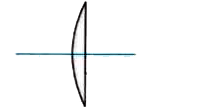The optical power of a double convex lens is 1.25 /m. Refractive index of lens is 1.5. Radius of curvature are 20cm and 30cm. Find refractive index of surrounding.
44762
44752
30/23
44767
To solve the problem, we will use the lens maker's formula and the relationship between optical power and focal length.
1. Identify Given Values:
- Optical Power (P) = 1.25 m⁻¹
- Refractive Index of Lens (n₂) = 1.5
- Radius of Curvature (R₁) = 20 cm (for the first surface, we take it as positive)
- Radius of Curvature (R₂) = -30 cm (for the second surface, we take it as negative)
2. Convert Units:
- Convert the radius of curvature from centimeters to meters:
- R₁ = 0.20 m
- R₂ = -0.30 m
3. Use the Relationship Between Power and Focal Length:
- The optical power (P) is related to the focal length (f) by the formula:
P=1f
- Therefore, the focal length f can be calculated as:
f=1P=11.25=0.8 m
4. Apply the Lens Maker's Formula:
- The lens maker's formula is given by:
1f=(n2−n1)(1R1−1R2)
- Substitute the known values into the formula:
10.8=(1.5−n1)(10.20−1−0.30)
5. Calculate the Right Side:
- Calculate 1R1−1R2:
10.20=5and1−0.30=−103
- Therefore:
1R1−1R2=5+103=153+103=253
6. Substitute Back into the Equation:
- Now substitute back into the equation:
10.8=(1.5−n1)(253)
- Calculate 10.8:
10.8=1.25
- Thus:
1.25=(1.5−n1)(253)
7. Solve for n1:
- Rearranging gives:
1.5−n1=1.25×325=3.7525=0.15
- Therefore:
n1=1.5−0.15=1.35
Final Answer:
The refractive index of the surrounding medium n1 is 1.35.
- Optical Power (P) = 1.25 m⁻¹
- Refractive Index of Lens (n₂) = 1.5
- Radius of Curvature (R₁) = 20 cm (for the first surface, we take it as positive)
- Radius of Curvature (R₂) = -30 cm (for the second surface, we take it as negative)
- Convert the radius of curvature from centimeters to meters:
- R₁ = 0.20 m
- R₂ = -0.30 m
- The optical power (P) is related to the focal length (f) by the formula:
P=1f
- Therefore, the focal length f can be calculated as:
f=1P=11.25=0.8 m
- The lens maker's formula is given by:
1f=(n2−n1)(1R1−1R2)
- Substitute the known values into the formula:
10.8=(1.5−n1)(10.20−1−0.30)
- Calculate 1R1−1R2:
10.20=5and1−0.30=−103
- Therefore:
1R1−1R2=5+103=153+103=253
- Now substitute back into the equation:
10.8=(1.5−n1)(253)
- Calculate 10.8:
10.8=1.25
- Thus:
1.25=(1.5−n1)(253)
- Rearranging gives:
1.5−n1=1.25×325=3.7525=0.15
- Therefore:
n1=1.5−0.15=1.35
The refractive index of the surrounding medium n1 is 1.35.
Topper's Solved these Questions
Similar Questions
Knowledge Check
Find the focal length of plano-convex lens of material having refractive index of 1.5. Radius of curvature of convex surface is 10 cm.
 A20 cmB30cmC50 cmD40 cm
A20 cmB30cmC50 cmD40 cmThe power in dioptre of an equi-convex lens with radii of curvature of 10cm and refractive index 1.6 is
A+12B+18C+1.2D+1.8The power of a biconvex lens is 10 dioptre and the radius of curvature of each surface is 10 cm. Then the refractive index of the material of the lens is
A98B53C32D43
The power of a biconvex lens is 10 dioptre and the radius of curvature of each surface is 10 cm. Then the refractive index of the material of the lens is
View SolutionThe focal length of a convex lens is 10 cm and its refractive index is 1.5. If the radius of curvature of one surface is 7.5 cm , the radius of curvature of the second surface will be
View SolutionThe focal length of a biconvex lens is 20 cm and its refractive index is 1.5. If the radii of curvatures of two surfaces of lens are in the ratio 1:2, then the larger radius of curvature is (in cm)
View SolutionThe focal length of a convex lens is 10 cm and its refractive index is 1.5 . If the radius of curvature of one surface is 7.5 cm, the radius of curvature of the second surface will be :
View SolutionA planoconvex lens is made of refractive index 1.6. The radius of curvature of curved surface is 60 cm. The focal length of the lens is
View Solution
